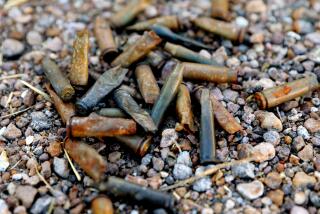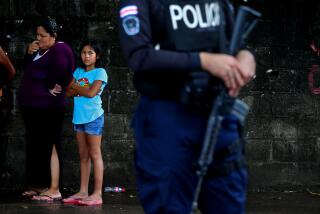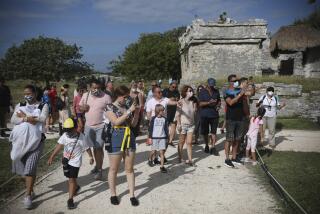The Other Caribbean : Far From the Resort Experience, the Undeveloped ‘Wild West of the Caribbean’ Is Rough, Ready and Still Affordable
SAN PEDRO, Belize — Chuck Cobb is driving a jeep over a rutted dirt trail cut through the thick tropical foliage of this little Central American country.
Jaguars hunt here at night, sometimes seeking the small wild hogs called peccaries that root about in the underbrush.
An unrestored Mayan temple that could pass for a vine-covered bluff looms mysteriously near the jungle’s edge. Giant silk-cotton trees studded with man-size bromeliads and wild orchids poke holes in the horizon.
Although surrounded by exotica of all shapes, Cobb hardly seems to notice. Like the proud farmer he is, he wants his visitor to see the new citrus trees he just got into the ground. The talk is all drainage and sour rootstock and growth yields.
Like other Americans who have immigrated here in search of blue skies unblemished by freezes and unpolluted by fast-lane congestion, Cobb sees undeveloped Belize as a sort of last frontier.
“You won’t find this challenge anywhere else,” he says. “I plan to be here for the rest of my life.”
Adds Catherine Christensen of the U.S. Embassy: “It’s like the Wild West in the Caribbean. It’s unknown and uncharted in many ways, and not an easy, comfortable destination. But it’s also kind of romantic.”
It’s that romance that is luring adventurous Americans to Belize.
Although it is the least settled of all Central American countries, Belize may be the friendliest.
Unlike most others, it is an English-speaking democracy with a free press, a forgiving legal system and an unarmed police force. There are no traffic signals and the tallest building in the country is an eight-story Mayan temple.
Independent since 1981, Belize (formerly British Honduras) sports a curious blend of Colonial British history and Caribbean rhythm. Most natives speak English with a Creole patois, rolling their vowels like the British pirates and woodcutters who founded the country 300 years ago.
From the air the thick tropical jungle and scrub that covers most of Belize pushes up against a thin, white beach for nearly the entire length of the country.
A few miles offshore, a foamy surf line marks the hemisphere’s longest barrier reef. Offshore, 250 deserted cays shimmer in the green shallows.
Scuba divers, who had traveled to Belize for years to explore its unspoiled, 185-mile reef system, were among the first outsiders to discover the country as an inexpensive, if slightly quirky, place to visit. They still make up the largest single faction of the small, but growing, contingent of U.S. visitors.
The rest of America began to catch on in 1988 after CBS’s “60 Minutes” told its 30 million viewers about a “tropical paradise,” named Belize, in Central America unspoiled by development or political wars.
Most tourist activities are centered around inland nature retreats and water sports. In addition to diving, snorkeling and sport angling--including bone fishing and reef fishing--Belize has a broad mountain range with white-water rivers and waterfalls, and extensive tropical rain forests.
There are many Mayan ruins such as Altun Ha, Xunantunich and Caracol--an immense ceremonial center recently excavated by archeologists from the University of Central Florida.
Belize also has a thriving zoo just outside of town that features native animals such as jaguars, toucans and the tapir, the national animal.
Other attractions include the 3,740-acre Cockscomb Basin Forest Preserve, established as a jaguar preserve in 1984 near Stann Creek, and Guanacoste Park, where natural orchids and bromeliads grow in profusion.
Belize City is a ramshackle mix of decaying British Colonial style and Caribbean funk.
Forty percent of Belize’s 170,000 people live in the city, and the cultures are as varied as the tropical fish on the reef--Mayan, Asian, British, Creole, Mestizo, American and European.
Throw in a large dose of archeologists, Peace Corps workers, celebrities, drug smugglers, fly-by-night speculators and assorted modern pirates and you have a real-life “Casablanca” populated by players right out of Hollywood’s Central Casting.
The Belize River runs through downtown and there’s a lively market near the river, over the Swing Bridge.
Although loggerhead turtles have been classified as a threatened species, they are butchered on the pier. Fruits and vegetables are peddled in crowded stalls. Oriental restaurants share the streets with little shops like Pete’s Pastries (on Queen Street) where $2 will get you three meat enchiladas, a large and tasty conch fritter and a homemade meat pie.
Belize City is generally safe, but is notorious after dark for pushy drug peddlers and muggers who can spot a camera-wearing tourist a block away.
Best bets for staying in the city, according to tastes, are the upscale Ft. George Hotel on Cork Street and the homey Ft. Street Restaurant and Guesthouse nearby.
Ft. George, managed by Paul Hunt, an affable Briton, has the best collection of literature on Belize in the country in its gift shop. Ft. Street, run by two American sisters, is a B&B; with five rooms, great food and a veranda in a quaint, old three-story colonial home. The bath is shared.
If you are a more adventurous backpacker or just like the local color, try Mom’s Triangle Inn downtown, with inexpensive rooms and food. The restaurant, which serves good American and native meals starting at $2, is on the first floor and the rooms, some of which come with a private bath, are on the second.
“Belize is an ‘alternative’ destination,” says Tommy Thomson, who runs Belize Promotions. “It has a very special attraction to certain people. But you come expecting a mini-Cancun, you’re going to be disappointed.”
Most tourists come to dive or explore the rain forest rather than to party or shop. That’s fortunate because there are few places to do either.
Scuba divers pass up Belize City in favor of San Pedro on Ambergris Cay, once a picturesque fishing village of 400.
Today, San Pedro is home to about 2,000 residents and is in the midst of a building boom. Real estate values have soared at a 40% rate over the last four years.
Despite its new prosperity, the little village has only three dirt streets, and lots of locals still draw their water from wells and use kerosene lamps.
As a result, San Pedro is full of contradictory images: Dented old Land Rovers rumble along next to electric golf carts from several upscale resorts just out of town.
Near an outdoor bar called Fido’s, a Mayan woman in a worn, native, print dress walks barefoot in the dust with a bucket of water. Nearby, a striking San Pedrano teen-age girl struts along in stone-washed jeans and Reeboks.
“Belize is a mirage,” says Emory King, a Jacksonville native and journalist who was shipwrecked here 38 years ago and has never gone home. “It’s whatever you want it to be.”
More to Read
Sign up for The Wild
We’ll help you find the best places to hike, bike and run, as well as the perfect silent spots for meditation and yoga.
You may occasionally receive promotional content from the Los Angeles Times.






